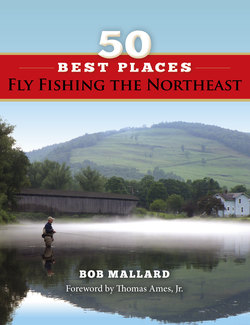Читать книгу 50 Best Places Fly Fishing the Northeast - Bob Mallard - Страница 40
На сайте Литреса книга снята с продажи.
ОглавлениеJohn Vacca fishing below Wyman Dam. Bob Mallard
Bob Mallard with Kennebec Gorge brook trout. Chris Russell
Much of the Kennebec River can be accessed from Route 201, which parallels the river for much of its length. Public access is limited in some areas. There is, however, walk-in access at three bridges, some boat launches, a multiple-use trail on the east shore in Bingham, a small ball field in The Forks, The Pines in Madison, and several private businesses.
The Kennebec is a large river by any standards. In many places the river is 200 to 300 feet wide. The two middle tailwaters are braided, giving you more water than you can fish in a single outing. The three upper tailwaters average roughly 8 miles in length, the lower about 2 miles.
Flows in the Gorge are feast-or-famine. Low flows are in the 325 cfs range—mandated morning and evening fish flows—and high flows are in the 5,000+ cfs range. There are very few flows in between, as the water is reserved for power generation and whitewater rafting. Several feeder streams add to the flow and can impact this section during runoff. Wyman flows are similar to those at Harris. Low flows run at 1,000 to 1,200cfs. Power-generating flows run at 5,000 cfs or more. When there’s no power generation, flows drop to 2,500 to 3,500 cfs. There is only one significant tributary, Austin Stream, less than a mile below the dam. After it rains, this can have a significant—but temporary—impact on the river. Below Williams and Abnaki, flows become more consistent. Flows usually run in the 3,000 to 4,000 cfs range and are not subject to the daily, and even hourly, changes experienced below the two upper tailwaters.
The Kennebec can be waded during low flows. It is tough to wade during high water. Fishing from a drift boat—or raft where appropriate—whenever possible is often the best way to fish regardless of flows. This allows you to cover more water. It also addresses some of the access issues noted above.
The three upper tailwaters are open from April 1 through October—the lower year-round. Prime time is May
and June and September and October. In July and August fishing is best below Harris and Wyman Dams. All four tailwaters are restricted to artificial lures only. Below Wyman, Williams, and Abnaki there is a one-fish limit and a minimum length limit of 16 inches on rainbows, browns, and salmon. The limit on brook trout is 12 inches. Below Harris Dam there is a two-fish, 12-inch minimum on all trout and salmon.
The trout in the Kennebec feed on minnows and insects. The predominant minnows are sculpin, fallfish, and smelts—which are found only below the Harris and Wyman Dams. Insects include stoneflies, mayflies, and caddis. Hatches on the Kennebec are strong and predictable. Mayflies start in mid-May and run well into June. They hatch intermittently in the summer and pick up again in the early fall. Caddis overlap early mayfly hatches, peak in the late spring and summer, and continue into the fall. Stoneflies can hatch pretty much anytime.
Below Wyman, Williams, and Abnaki; the Kennebec is a classic dry-fly river. It is one of the few rivers in the area that offers season-long dry-fly fishing. Even in the heat of summer, most evenings will see a caddis hatch. Fish are also regularly caught on nymphs. On overcast days, fish will take streamers—including some of the largest trout.
Pteronacys.
Bob Mallard
